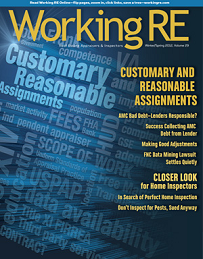
|
Published by OREP, E&O Insurance Experts | June 6, 2012 | Vol. 253 |

|
> Blogs
> Leave Comments Below |
Have you ever given thought to merging your appraisal practice with another
to improve efficiencies and the bottom line?
Upcoming Webinar:
Can You Increase Your Appraisal Volume AND the Quality of Your Work?
Editor’s Note:
Although
there are some drawbacks, merging with another appraisal practice with similar
problems and objectives is one of the ways to achieve greater success.
Merging
Appraisal Practices: Part I
By Lloyd R. Manning
Have you ever given thought to merging your appraisal practice with another to improve efficiencies and the bottom line? If the concept is new to you……keep reading.
As a seasoned appraiser with several or many years’ experience and a growing
client list, without question you would consider yourself in a profession where
the needs of your clients are first and foremost. But the facts of life are
that you are running a business that incorporates market economics, efficiency,
productivity, changing demographics, and the foresight to meet present and
future challenges. To survive and prosper it is necessary to make a profit;
this, in the face of declining revenues, increasing expenses, and more
competition.
To meet these and other tests, many smaller and specialty appraisal practices
are looking to merge with other smaller appraisal practices that have different
specialties or are more diversified. The objective is to better enable
themselves to compete and prosper in today’s business environment. Although
there are some drawbacks, merging with another appraisal practice with similar
problems and objectives is one of the ways to accomplish this goal. Most times,
when put altogether, merging two or more practices into one makes sense.
Synergy
Many professional practices and businesses, for that matter, are merged for
synergistic reasons. The total benefit to be attained by the larger firm is
greater than the sum of the individual practices. Two plus two equals five or
more. Economics of size often produce cost savings. Greater utilization can be
made of the combined resources, fixtures and equipment, waiting room, office
area, washrooms, storage and common areas. It can be more cost efficient in that
there will be better use and less duplication of ancillary and clerical staff,
services, and billing systems.
Cost savings will be realized through joint usage and the pooling of financial
resources. It will allow a greater ability to acquire and utilize more recent
and updated computer and other equipment. Today’s business environment requires
substantial amounts of investment and working capital. New technology is
expensive and because of constant updating so much of it has a short shelf life.
Many clients, particularly developers, are not fireballs when paying. Banks are
often reluctant to extend substantial amounts of credit to professional
practices, particularly start ups, and you seldom have the luxury of obtaining
outside investors.
Bigger Is Often Better
All appraisers
strive for zero defects or to get as close to it as is humanly possible.
Although professionalism is paramount, flexibility is ultra important. This
requires constant practice, control and peer review procedures that only the
larger appraisal practices can support. Still, underlying all else is client
satisfaction and retention coupled with the requirement to provide exemplary
service; this must be correlated with the economics of scale. To survive in
today’s business environment, all professional practices, including appraisers,
must expand their rosters of professionals and technicians who possess the
required expertise to offer differing services to a wider variety of and more
demanding clients.
The principal advantage is that a merged practice of two or more appraisers,
each with different specialties, offering a full range of services, is better
able to provide better and more diversified service to its clients and compete
in the marketplace. A larger practice can garner and retain business where it
otherwise may not have been able to do so. And, it benefits the individual
appraiser in that it allows him/her to advance their profession beyond what they
could have previously done. An appraiser can perform those functions in which
he/she has a high level of expertise while passing other clients to a partner.
However, the marketplace will always dictate size limitations and compatibility.
Other advantages include a greater ability to adapt to changing circumstances,
and improved negotiating ability with larger clients, including banks, mortgage
companies, law offices, insurance companies, and government departments. A
merged practice should be able to more readily recruit other appraisers and like
professionals. Each appraiser is now able to better advance him/herself in the
profession that would not have otherwise been possible.
Downside
On the other hand,
there are disadvantages. Sometimes amalgamations are brought about because of a
crisis situation, which is the worst of all reasons to merge: it won’t eliminate
all of the problems and could exacerbate some. The larger the practice, the more
direct control management will be required. Not all appraisers are good managers
(they would deny this) and some who might be good do not want to assume the
responsibility. Where one does, agreeing on suitable compensation can be a
touchy issue when taking into consideration that time spent managing the
practice is time away from professional practice duties. If the practice is of
the size where full time management would be beneficial, it is often wise to
employ a person competent in this area.
The principal shortcoming is incompatibility with the other merger partners and
differing expectations of what the merger will accomplish. Not everyone is a
team player. Yet, this is what each must be if the merger is to be successful.
Incompatibility problems can take different forms. There are conflicting
objectives, differing talents, ability, work ethic and financial contributions.
Some wish to work hard and develop their practice, others are more interested in
family life or recreation. There are leaders and there are followers. Still, all
must promote the welfare of the group, not that of any individual appraiser in
preference to others. The hierarchy among individual practitioners must
disappear. There cannot be a pecking order.
Where to Begin
The starting point
for a merger of two or more appraisal practices is a meeting with the
prospective merger candidates and having a general round table discussion of
what is wanted and what is expected by the individuals, what the group hopes to
accomplish, what each brings to the table, and procedural matters. When there is
a melding of objectives, all have agreed to the basics and have laid out the
rudimentary guidelines, the next step is to undertake a detailed pre-merger
assessment and valuation of each individual practice that is intended to
participate. It is best to have one neutral professional analyst and/or a
professional practice appraiser conduct this task. By this assumedly all bias is
eliminated. The analysis should include:
· Market value of each individual practice, the tangible and intangible assets, including the goodwill;
· History of each practice, annual billings, collections;
· Details of the services each practice offers, particularly specialties not available everywhere;
· Staff of each practice, their salaries, duties, competency, length of service, etc.;
· Facilities that could be occupied by the new practice, or abandoned;
· A general economic analysis of each practice with a clear understanding of what each brings into the merger. (Senior professionals are seldom interested in supporting poor performers.)
· Untapped or undercapitalized potential;
· An economic and personal analysis to ensure that all are compatible;
· An assurance that each will be better off after the merger.
**Merging Appraisal Practices Part II: Nuts and Bolts will be in a
future edition of Working RE Online, OREP Members / Working RE Paid Subscribers
can access it online now:
click here. (Am
I a Working RE Subscriber?)
About the
Author
Lloyd R.
Manning, AACI, FRI, CCRA, a commercial real estate appraiser, broker and
consultant for over 30 years. His most recent book is Winning with
Commercial RealEstate: the Ins and Outs of Making Money
In Investment Properties. It covers the entire field of appraising, buying
financing, leasing, managing and selling a wide variety of investment,
commercial, and industrial properties (Booklocker.com, Barnes & Noble, Amazon,
or Chapters-Indigo).
HTML Comment Box is loading comments...
ATTENTION: You are receiving WRE Online News because you opted in at WorkingRE.com or purchased E&O insurance from OREP. WRE Online News Edition provides news-oriented content twice a month. The content for WRE Special Offer Editions is provided by paid sponsors. If you no longer wish to receive these emails from Working RE, please use the link found at the bottom of this newsletter to be removed from our mailing list.



